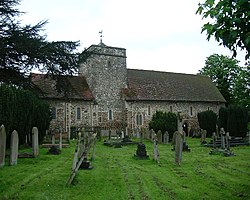Finnish
Bosley first encountered the Finnish language when he was given a Finnish-English dictionary by his uncle during his youth. Afterwards, he studied Finnish it with a grammar written in German. Finding William Forsell Kirby's 1907 translation of the Kalevala in a used bookstore, he became irritated by its lack of fluidity, and resolved to read the original Finnish. [2] [3]
As a translator, Bosley realised several books of Finnish folk poetry into English, as well as modern works: The Last Temptations by Joonas Kokkonen, Whitsongs by Eino Leino, and work by Aleksis Kivi as Odes. Over the course of several decades, Bosley translated and published the Kalevala, a 22,795-verse-long epic poem compiled and edited by Elias Lönnrot from the folk poetry of Karelia and Finland; the poem is Finland's national epic. [4] [2] In 1966, and again in 1971, Bosley published extracts of it for children, and two years later published the fourth canto under the title The Song of Aino. In 1977, folklorist Matti Kuusi and linguist Michael Branch, having seen these poetry translations, brought him to work together on a bilingual anthology of Finnish verse, which was released in 1977. [2]
Bosley published some verses of the Kalevala in 1985, but a full version only appeared four years later: due to its older style and ideas, the text was more challenging to work on than others. Bosley wrote about his experiences in translating the work and his philosophy of translation in Taking the Rough with the Smooth, and an article, Translating the Kalevala: Midway Reflections. In these, he wrote of his responsibility as translator towards the text, and the importance of not introducing himself into the text, and thereby hindering connection with the original author. Thus, he stood against using more modern free metre and using modern phrasing. Bosley especially had issue with finding an appropriate metre - Finnish poetry uses metre constructed on a unit of syllables, whereas English-language poetry uses multi-syllable feet. However, he found using feet too flat, and so to find a natural-sounding metre drew on the cywydd of Middle Welsh poetry he had read as a child: [2]
The only way I could devise of reflecting the vitality of Kalevala metre was to invent my own, based on syllables rather than feet… I eventually arrived at seven, five and nine syllables respectively, using the impair[ sic ] (odd number) as a formal device and letting the stresses fall where they would.
— Keith Bosley, The Kalevala, preface
The work took five years, with Bosley translating one hundred verses every night during shifts at the BBC. When published in the Oxford World's Classics series, it attracted praise from reviewers, especially for his metre. The edition saw reprints in 1990 and in 2008; [2] after his wife suggested he make an audio-book version due to his skill in narration and experience with the text, he recorded and released an audio edition with Naxos in 2013. The audio-book spanned 12 CDs, with a duration of roughly thirteen and a half hours. [3] In addition to the Kalevala, Bosley also rendered much of the Kanteletar , another less widely-known collection of Finnish verse by Lönnrot, into English. Here, he was the first to do so, publishing in 1992. [5] A year later, he again worked with Branch, alongside Lauri Honko and Senni Timonen, to produce a large work of poetry from across the Finno-Ugric peoples and languages: this comprised over 30 poets, 450 poems, and 13 languages, including Veps, Mordvin, Udmurt, and Livonian. [2] [6]


